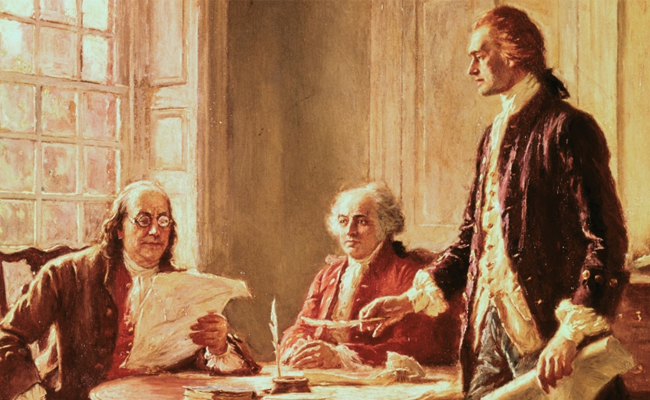A Q&A With Thomas J. Craughwell, Author of Thomas Jefferson’s Creme Brulee
We sat down with Thomas J. Craughwell, the author of Stealing Lincoln’s Body, Saints Behaving Badly, and Quirk's This Saint Will Change Your Life.
In the quick Q&A, he talks about his latest book with us, Thomas Jefferson's Creme Brulee. Read on!
Q. What first gave you the idea to tell this story?
A. As the titles of a couple of my other books suggest—Stealing Lincoln’s Body, Saints Behaving Badly—I’m drawn to off-beat stories. Typically I come upon these stories by chance. That was the case with this book. I knew Jefferson had been in France for five years, and I knew that he was food-and-wine hound. In spring 2011 I was reading a book about Jefferson when I came upon a reference to Jefferson having one of his slaves trained in the art of French cuisine. I did a little hunting around in libraries and found there was enough material for a book.
Q. What made Thomas Jefferson’s eating habits so different from his colonial contemporaries?
A. In the 18th century, Americans and their cousins back in England were heavy meat-eaters. Jefferson preferred vegetables, with a little meat as a side dish or a condiment—that made him unusual. Furthermore, he was an adventurous diner—Jefferson was growing and eating tomatoes when most Americans still believed the fruit to be poisonous. And while most Americans considered simple food prepared in an uncomplicated manner a sign of republican virtue, Jefferson had a deep interest in sophisticated cooking techniques and in dinners that brought a succession of interesting flavors to the table. Patrick Henry, one of Jefferson’s severest critics, denounced him as a man who had “abjured his native victuals!”
Q. The book presents accounts of Jefferson’s scientific approach to gardening, but also his adventurous approach to eating. What do you think made Jefferson so focused on food? Would you say he thought of it as a science or an art?
A. Fundamentally, Jefferson was a farmer. That’s how he made his living. Granted, Monticello was not a typical farmhouse, and Jefferson not a typical farmer. Nonetheless…. He had a scientific mind, so he was always on the look-out for more efficient ways to raise crops, to increase harvests. He experimented with hundreds of varieties of fruit and vegetables to find the ones that were pest resistant, that flourished in the Virginia climate, and also tasted great. But in addition to having a scientist’s mind, Jefferson’s had a gourmet’s palate. The food he grew was brought to his table, so he wanted the best.
Q. The book shows a Thomas Jefferson enamored with French culture and quite disappointed to leave his home there. Was cuisine a way for Jefferson to bring a bit of France home with him to the U.S.?
A. Absolutely. But he wasn’t selfish about it—what he learned and acquired in France he wanted to share with his fellow Americans. He hoped to see Arborio rice and olive groves flourishing in South Carolina, and he thought he could produce America’s first grand cru wines at Monticello. Alas, in Jefferson’s lifetime, none of those grand ideas panned out.
Q. There is little written record of James Hemings’ life. How did you begin to piece together his story with such limited source material?
A. I wish we knew much more about James Hemings. That said, we know more about him than we do about most slaves in the 18th-century America. James and his brothers and sisters had been fathered by Jefferson’s father-in-law. So the members of this slave family were Thomas Jefferson’s sister- and brothers-in-law. They were the most privileged slave family at Monticello, and they appear often in Jefferson’s household records as well as his personal correspondence. Monticello’s encyclopedic website has a lot of information about James Hemings and his family. But the absolutely indispensable resource is Annette Gordon-Reed’s book, The Hemingses of Monticello.
Q. What lasting impact do you think Thomas Jefferson and James Hemings had on the American culinary landscape?
A. I’ll bet that right now there is a bottle of olive oil in your cupboard and some grated or perhaps a wedge of Parmesan cheese in your fridge. I’ll bet you sip champagne at major celebrations, and order crème brulee for dessert when you dine out. And I’ll bet that your kids love mac and cheese, and that you and everyone you know loves French fries. Jefferson and Hemings introduced all this good stuff to America.
Q. How are Jefferson’s ideas about food similar to the foodie revolution happening today?
A. Jefferson ate what was fresh and in season. He liked a succession of courses at his dinners—even when he dined alone—but he did not gorge himself. You could say that Jefferson was an early advocate of portion control. And he ate more vegetables and fruits than meat or carbohydrates.
Q. If Thomas Jefferson were a celebrity chef, which one would he be?
A. No doubt in my mind, Jefferson would be Iron Chef Masaharu Morimoto. Like Morimoto, Jefferson was a perfectionist. The food had to fresh and in season; it had to taste delicious; and the plating (to use a contemporary foodie term) had to be visually appealing, even stunning if possible. James Hemings mastered all those components, which explains why Jefferson found it so hard to let James go.
Eric Smith

ERIC SMITH is the cofounder of Geekadelphia, a popular blog covering all-that-is-geek in the City of Brotherly Love, as well as the Philadelphia Geek Awards, an annual awards show held at the Academy of Natural Sciences. He’s written for the Philadelphia Inquirer, Philadelphia Weekly, and Philly.com



